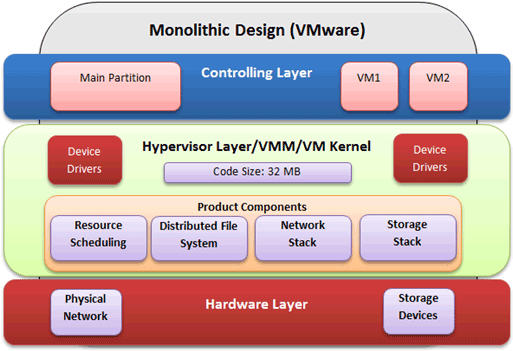At the same time, there are a few disadvantages associated with the Microkernelized Hypervisor Design that are important to highlight:
- The Microkernelized Hypervisor Design requires an operating system to be installed in the “Controlling Layer” before the “Hypervisor Layer” can operate. This is the biggest disadvantage.
- If the operating system running in “Controlling Layer” crashes for any reason, then all other virtual machines will also crash.
- More overhead is required for the operating system running in the “Controlling Layer” to manage the communications between the virtual machines and the “Hypervisor Layer.”
- Every organization maintains the security of Windows operating systems by means of applying security updates released by Microsoft. So the operating system running in the “Controlling Layer” must also be applied with the latest security updates.
As part of the security updates, the Operating System will be rebooted, which in turn requires you to take all virtual machines offline — or move to another node in the cluster without any downtime with the help of Hyper-V Live Migration feature.
Monolithic Hypervisor Design
As you can see in below figure, VMware’s vSphere uses the Monolithic Hypervisor Design, which requires the hypervisor-aware device drivers to be hosted in and managed by the “Hypervisor Layer.” This is what we see in the “Hypervisor Layer” in the below diagram; the device drivers are part of it:
Hypervisor device drivers must be developed and included in the “Hypervisor Layer” before you can start using the vSphere virtualization product. You cannot run VMware vSphere on hardware that is unsupported.
VMware vSphere operates its components in the “Hypervisor Layer” as shown in the above figure. Product components that it operates are Resource Scheduling, Distributed File System, etc. The Network Stack component, which is responsible for implementing the VMware networking, also operates in the “Hypervisor Layer.” The Storage Stack component allows “Controlling Layer” components to access storage devices.

The Monolithic Hypervisor Design provides the following advantages:
- No operating system is required for controlling all the components of the virtualization product. This is the biggest advantage over the Microkernelized Hypervisor Design used by the Microsoft Hyper-V as discussed above.
- No security patches are needed for components running in the “Controlling Layer.”
Disadvantages of Monolithic Hypervisor Design:
- VMware’s vSphere does not work on hardware that is not supported. However, VMware has developed a list of compatible hardware on which VMware vSphere is able to run successfully. The list can be found at http://www.vmware.com/resources/compatibility/search.php.
- More initialization time is required. In this design, the initialization time required for the VM Kernel depends on the size of device drivers included in it.
- Since device drivers are initialized as part of the “Hypervisor Layer” initialization, any corrupted foreign code injected in the “Hypervisor Layer” can delay the booting/initialization or cause the server to hang in some cases.
Conclusion
In the article we discussed how Microsoft Hyper-V and VMware vSphere operate differently from each other. We explored how each of the virtualization products uses a different virtualization architecture: Microkernelized Hypervisor Design for Microsoft Hyper-V and Monolithic Hypervisor Design for VMware vSphere.
We also covered some of the primary advantages and disadvantages each virtualization product offers, which IT workers or organizations should find valuable when determining the best virtualization product for implementation in their production environment.
Nirmal Sharma is a MCSEx3, MCITP and Microsoft MVP in Directory Services. He has specialized in Microsoft Technologies since 1994 and has followed the progression of Microsoft Operating System and software. In his spare time, he likes to help others and share some of his knowledge by writing tips and articles on various sites and contributing to Solution IDs for www.Dynamic-SpotAction.com.Nirmal can be reached at [email protected].

